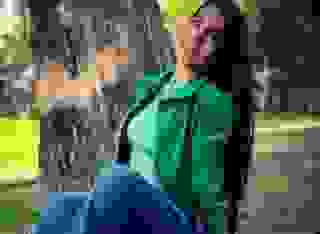- Romance
- Twin Towers
Note: You can change font size, font face, and turn on dark mode by clicking the "A" icon tab in the Story Info Box.
You can temporarily switch back to a Classic Literotica® experience during our ongoing public Beta testing. Please consider leaving feedback on issues you experience or suggest improvements.
Click hereCopyright Oggbashan August 2021
The author asserts the moral right to be identified as the author of this work.
This is a work of fiction. The events described here are imaginary; the settings and characters are fictitious and are not intended to represent specific places or living persons.
+++
"June? Did you get Gerald's email?"
"Yes, May. I'm reading the attachment now."
June and I are twins. born either side of midnight on 31 May, hence our names. We live in a Victorian large house built in Strawberry Hill Gothic inside the remains of a small Roman fort on an estuary in East Anglia.
The fort's remains are little more than a rough line of stones marking where the walls had been except for a large mound covering the remains of two towers, side by side. Unusually the towers hadn't flanked a gate or postern. Now they had a balustrade viewpoint on top of the lower towers with a great view of the estuary. That mound had been known as 'the twin towers' far as far back as records went.
Our distant cousin Gerald had inherited the house from his grandfather, our great-uncle. It was fortunate that he had a very well paid job in the City of London because maintaining the house and estate was expensive. May and I lived on site and acted as his estate mangers for the house and the tenanted farms.
He had emailed us because one of his work colleagues had been doing some research work on the Vindolanda tablets and had found a reference to our Roman fort. The letter had been a never sent draft and had not been signed.
It was addressed to 'The Twin Towers' with an abbreviated version of the Roman name for the Fort.
"Greetings, Julia and Augusta. I can never forget your birthdays because you were born either side of midnight. It is cold up here, covered in snow. I remember visiting you last summer. The memory warms me up. Have you still got the secret vault? I suppose I shouldn't mention that. In my final version of this letter I won't."
The letter goes on to mention mutual friends etc. But scrawled across the last paragraph is a bold message:
"Curses! Julia and Augusta are dead, killed by sea raiders against whom they fought bravely. I will miss them if I survive."
It was interesting in that even then, the twin towers were called that, and occupied by twin sisters nearly 1,700 years ago when Rome's influence on Britain was waning. We felt an affinity with Julia and Augusta, as twins born at a month's end.
We knew far more about Julia and Augusta than almost anyone from that era. One of our Victorian ancestors, an antiquary, had been checking the foreshore after a large winter flood when he found their tombstone about twenty yards in front of the towers. It had fallen face down, presumably after a historic flood and was perfectly preserved. It is now in the county's museum. It had been erected by an Ennius and gave the year, about twenty years before the Romans finally left Britain, but not the day of their deaths.
It showed full length portraits of the two women and some of the paint had survived so we know they were redheads. They were formally dressed as Roman women but with sword belts and swords. Their hands were resting on their sword hilts, and one, like me, was left-handed. Standing behind them, with a bare torso, was Ennius, his magnificent black beard contrasting with the women's red hair. He had been about half a head taller than the women. The memorial read:
"May the Gods of the Underworld, and their God, show honour to Julia and Augusta, twin sisters, two freed British slaves who were the lovers of Ennius, the fort's commander. They died, swords in hand, defending Ennius."
There is a slogan below:
"Fierce in bed, fierce in combat. Honour them."
The tombstone also shows a small picture of the Twin Towers with a house behind them built on a solid base level with the wall walk. It is labelled: 'Their home'. There were Christian crosses on the four corners.
Our ancestor had a copy made and coloured as then research thought was right. Subsequent examination of the original in the 21st century has shown the Victorian colours were slightly wrong. But he installed a copy between the two towers, and two years ago Gerald had it restored to the full colours we now know are correct.
Below that replica the ancestor had installed another plaque:
"Please pray for the souls of Julia and Augusta, brave Roman Christians. Remember them."
In the 1960s their graves were found about ten yards away. There were no bones, but two rusted Roman swords were recovered in pieces, together with two metal crucifixes which bore their names. They had been buried in a Christian alignment, but including swords with Christians, especially Christian women, was very unusual. The other odd items were two gold arm rings, engraved with pagan symbols. Those were definitely not Roman. The archaeologists who found them had placed a small stone plaque, with just their names, to mark the grave site. That plaque was often covered with flowers from us and other locals.
For the last five years, on the weekend closest to the thirty-first of July, we have held a weekend for them.
May and I play Julia and Augusta. Although we are redheads if slightly less bright, for that weekend we match their actual hair colouring as shown on their restored memorial. Gerald portrays Ennius. On the Saturday, the local Roman re-enactors, who have adopted the two women as their mascots, defend the fort against anachronistic Viking re-enactors who storm ashore. May and I 'die' defending Gerald and in the evening we have a funeral feast with much drinking by both groups. May and I return to 'life' for the festivities.
On the Sunday we all go to the local church for a memorial service followed by lunch and more 'fighting'. Sunday evening is for more drinking and singing of specially composed songs about the two women with perhaps more about their prowess in bed than in swordsmanship. The evening can be very rude and for that evening alone, no children are allowed anywhere near.
Julia and Augusta are not ghosts who haunt the Twin Towers. However, whenever standing on the mound that was their home, May and I feel that they are close by. Sometimes both of us share dreams in which we become them.
The discovery of the Vindolana letter has made May and I feel even closer to Julia and Augusta. It will be the memorial weekend in a week's time and Gerald will come from London on the Friday before. It is awkward. May and I both love Gerald and he loves both of us, but he can only marry one. We two have decided that on the Saturday night we two revived Roman women will have Gerald in our bed, as Ennius was in Julia and Augusta's bed. Will he choose one? Ennius didn't.
On the Thursday lunchtime we had a text from Gerald. He had bit hit by an idiot on an e-scooter and was on crutches. Tomorrow he would come with Mark, a distant relation, who had recently returned from a contract in Dubai. Mark was staying with Gerald while house-hunting. Gerald told us Mark had an appropriate beard, but like him, would have to colour it. He thought we would have no problem persuading Mark to stand in as Ennius. Mark hadn't seen us for a decade, when we were still children, so he as interested to see what we were like in our twenties.
That night May and I slept in the large state bed, four-poster with curtains. Sometimes we shared a bed. When we had first came to this house, the four-poster bed was the only draught-free place to sleep. Now Gerald's money had made the house sound, water and draught proof, but still in need of major renovation which might take years as money was available.
As sometimes had happened before, we found ourselves in shared realistic dreams as Julia and Augusta, sharing a bed with Ennius. Maybe we share a dream because we are twins and think alike. I don't know. We just accept that we have the same dreams. Ennius was a virile and very satisfactory lover, arousing both of us to frantic activity. In the early hours we were startled to find that we had resumed being ourselves but joined in the bed by Julia and Augusta. The three of them spoke to us in our dreams.
"Ladies?" Ennius said. "Before I, Julia and Augusta died, I was in constant trouble with the Roman civil governor. I was commander of the is small fort which was little more than a stores depot for the Roman navy. I had fifty men, not really enough, but the navy rarely came. About two years earlier I had a large delivery of equipment intended for two centuries which were to be added to understrength legions on Hadrian's Wall, but they never came. They were diverted to Italy.
Even then I was worried that Rome would withdraw from Britain and I thought that local British townspeople should be equipped and trained to fight if the Roman army left. The governor didn't agree and he insisted that Britons should not be trained for war. All I could do was train the locals in trades that might not exist when the Romans left. The twin towers were originally planned to be a four tower gatehouse leading to the harbour, but as we started to build we found that the slope to the harbour had become eroded and was now too steep, so the towers never became a gate.
The incomplete second towers had two large voids which would have been guardrooms. I persuaded some locals to work on them, to make the lower parts into a secure cellar, and the upper part a house for Julia and Augusta. The work was unnecessary but gave me an excuse to train masons, carpenters, blacksmiths etc.
When the cellar was nearly covered by a vaulted roof, I put the equipment intended for the two centuries in there, leaving a small, concealed access hatch. Only Julia, Augusta and I knew that the cellar wasn't empty and very few knew it was there. But the towers were never completed to be Julia and Augusta's house. They died about a month before the towers would have been ready. When I was killed about five years after the two women had died, no one knew that the cellar existed, except the lady who wrote the letter, a close friend of Julia and Augusta, but even before I died, she had been long dead too so no one knew.
Over the years many army units had sent me things for safe keeping to be returned to the Empire when needed, but no one ever asked for what I was storing. I added things through the small hatch but everything is still there. What is stored is no longer need for an Empire that hasn't existed for many centuries so you and your cousin Gerald can have everything.
You will need to be careful. The cellar is airtight and opening it might cause damage. You will need professional archaeologists to expose it, under the mosaic floor of the dining room of the twins' house. My hatch is under the picture of the gates of Avernus. That section lifts out to show a slab beneath.
We didn't know that there was a mosaic. Over the centuries, as the towers decayed, the lower rooms had been filled with rubble to help support the upper sections, which were now much lower than they would have been in Ennius' time. The top of the two towers had been levelled off to make a viewing platform.
June and I decided that we would mention our dream to Gerald when he came. We knew he would take it seriously. He was aware that we sometimes shared dreams and because we are twins, could sometimes covey meanings to each other without talking. He thought it was slightly weird but just accepted it as part of who we are.
+++
When Gerald arrived, driven by Mark, although he was on crutches it was obvious that he wouldn't need them soon. He was bruised by not seriously injured. June and I found that Mark was nearly as satisfactory to kiss as Gerald, he seemed to be impressed too. He hadn't expected such an enthusiastic welcome. He looked like a closer relation to Gerald than he actually is. It didn't take us much effort to persuade Mark to act the part of Ennius, particularly as I offered to show him that night what Ennius could do in bed.
That evening, sitting in front of an open fire in the house's living room, June and I told Gerald and Mark about the message Ennius had given in the dream. Mark was sceptical, but Gerald believed us.
"That could be difficult," Gerald said. "Not only do we need archaeologists who could be persuaded, but we would need to prop up the top of the towers. But even before then, we would need permission to excavate on a scheduled ancient monument. Getting that permission could take months or years, even if we involved say a university's archaeology department to help us with the paperwork. And what proof have we got? A dream? The authorities won't be impressed by that."
"When was the last archaeological work done, Gerald?" I asked.
"In the 1960s, my grandfather's time. That was when they found the tombs. They couldn't get permission to dig inside the walls, so they dug outside. All they did inside was record and plan everything that could be seen above ground, without touching anything."
"But they could do more now, surely, even without digging." I said. "I have seen ground penetrating radar in use on TV programmes. That wouldn't disturb anything but might provide evidence for permission for a dig?"
"Maybe. There will be several of our local university's archaeological department at this weekend's enactment. I will ask them what they think."
"Thank you, Gerald. That could be a start."
"You really believe in this dream, don't you, May?" Mark asked.
"Yes, Mark. June and I have an affinity with Julia and Augusta. We weren't surprised by the dream. We have ad several about those two, but this one was the first in which we were told about something we didn't know. That's odd and we would like to know if there is any reality."
"Don't build your hopes too high, May," Gerald said. "Getting permission will not be easy and even if we did, getting agreement to dig inside the towers might eb too far."
+++
That weekend Mark was a very satisfactory Ennius during the re-enactment and even better in bed with me. Gerald and June found his bruises limiting but by the end of the night they had managed twice.
But on the Sunday evening both men had drunk too much to be satisfactory lovers in bed. But both promised to come back for a long weekend in a month's time, so June and I had to settle for hope of better couplings in future.
Gerald had spoken to the university's archaeologists, and had walked around the castle site with them. They were excited at the prospect of digging somewhere that had never been dug before, but they shared his doubts about whether they could get permission. They could and would do a radar survey to try to see what might be inside the walls. If they could get permission, they wanted to involve the students from all years for hands-on experience, particularly as the castle was only twenty minutes drove from their campus.
+++
A month later, Mark and Gerald were back. This time, with no excess of alcohol, they performed to our satisfaction in bed. They were nearly as good as the dream Ennius, if not better because they were real.
There was a bulky letter from the Head of Archaeology at the University. The results of the radar scan had been better than they had even hoped. They had found the buried walls of what had been the barracks and store rooms and two filled in wells. But where the twin women's original house had been, before they moved into the twin towers, it appeared that not only were the walls several feet high above the original Roman ground level, but there were substantial voids underneath the floor level.
They hadn't been able to survey inside the twin towers because of the rubble, but they had found severe cracks in the walls which could make the towers unsafe. The archaeologists had taped off the viewing platform on top. As part of their request to dig, they had asked whether the towers' walls could be sympathetically stabilised. If they did that, they would have to remove the rubble first and prop up the structure while it was repaired. So far all they had received was an acknowledgement and a promise that a heritage inspector would visit with a week or so.
Two weeks later Gerald had a shock. He had been sent a formal notice that the two towers were in imminent danger of collapse. The areas inside and outside the walls would have to be fenced off. Repair of the towers would have to be done by a specialist contractor at a cost of eight to ten thousand pounds. A grant of one third of the cost could be made available, but Gerald, as the owner would have to fund the rest.
"Ouch," he said. "May, June? I hope you are right and there is something there. That is serious money even for me."
He wasn't serious. The sum would be a small part of his annual bonus. He wrote back agreeing for the work to be carried out, with help from the University's students. Scaffolding would have to be erected to support the Towers, then the grassed ramp leading to the top would have to be taken away carefully because of was that ramp which was pushing at the towers. The soil on the top would have to be carefully removed and analysed by the archaeologists before the rubble could be slowly removed as the contractors worked on the outside walls. It would take eight months to a year before we could get down to the mosaic, if there was one, as we had seen in our dreams.
A few weeks later the contractors had erected a strong scaffolding frame to support the towers and stop them moving. The students started to remove the grass and earth on top of the towers. They and we were surprised. The earth had apparently been added in the late 19th or early twentieth centuries. There was only one access to the top of the towers, apparently a trapdoor which had been covered by the Victorians with a heavy iron plate. Underneath was the original top of the towers, with marks to show where catapults had been mounted on both towers and even some of the parapets were still there. We had been misled by a surviving 18th century print showing the view from the other side of the estuary. The artist must have exaggerated the height of the towers for effect.
The soil had some early twentieth century bottles but nothing earlier. But when the students stared on the earth ramp they and their professors became excited, The top layer had Victorian glass are but lower down were Georgian, and earlier glass and pottery going back to early medieval. Once the ramp had gone they started on the rubble filling the Towers. The contents were almost all medieval or even earlier. The rubble must have started to accumulate in the Anglo-Saxon period.
As the rubble was carefully removed hey found the start of a long Latin inscription carefully cut into the stone wall. When fully exposed it read, translated:
"Remember Julia and Augusta, brave British women, who died in this chamber, swords aloft. They refused to climb the ladder in their long robes and stayed with three of the garrison to protect the ladder as it was hauled up by the remaining ten men including their lover Ennius. They fought well, killing four of the raiders before they were cut down. The raider's chieftain was so impressed with their bravery that he put golden arm rings on their dead sword arms before he withdrew because Roman ships were approaching. Their actions saved the survivors who had destroyed two of the raider's' ships by catapult. Honour those two forever."
A foot below that inscription were the words:
"The immortal shades of Julia and Augusta are dedicated to the Gods of Rome, and their God, by a sorrowful Ennius."
A female student, as soon as the full inscription was exposed, asked me for a vase in which she put some wild flowers. Later, when all the rubble was gone, we put a small table by it with more flowers.
Much later we had a board made with the inscriptions translated into English. There were two crucifixes attached to it. We were not allowed to fix it to the historic wall so we just leaned it against the wall below the inscription.








